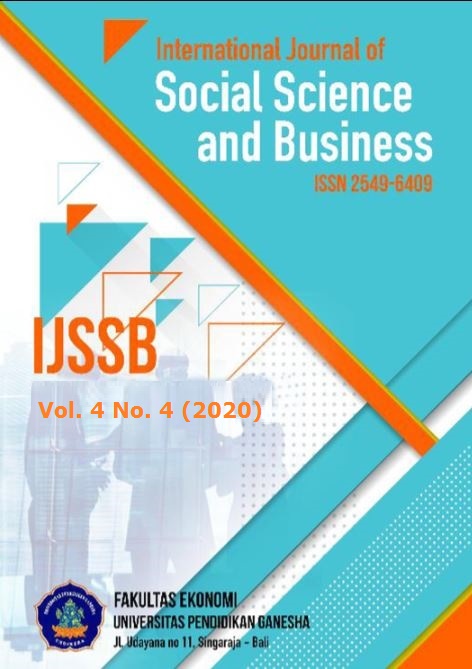Comparative Study on Indonesian and Philippine Marine Exploitation and The Fish Consumption
DOI:
https://doi.org/10.23887/ijssb.v4i4.25685Keywords:
marine exploitation, sustainable development, community development, Indonesia, PhilippinesAbstract
Indonesia and the Philippines are the two biggest archipelagic countries in the world spanning more than 25,000 islands. This made both states rich in marine natural resources and were considered to be the global centers of marine biodiversity. With the said availability of aquatic resources, both countries have also experienced the exploitation of these assets by people aiming to make profit from overfishing and illegal, unreported, and unregulated fishing practices. As such, the authors saw the merit of exploring the recently-implemented policies of both countries aiming to protect and preserve their marine natural resources. These were vital in assessing its effects on the human consumption of fisheries and triangulating the effectivity and efficiency of the said aquatic-related public policies. This study presented the concrete actions that both Indonesia and the Philippines took to battle illegal poaching by Chinese fishermen in the latter’s waters, prevent the marine exploitation of fishing operations from the former, and the establishment of community-based marine preservations that gave permanent employment to its population and improved their way of living.
References
(Department of Agriculture-Bureau of Fisheries and Aquatic Resources).
Aliño, P. M. (2002). An overview of Philippine fisheries [Marine Science Institute, University of the Philippines, Quezon City]. http://innri.unuftp.is/pdf/Philippine Fisheries.pdf
Ariani, M., Suryana, A., Suhartini, S. H., & Saliem, H. P. (2018). Keragaan Konsumsi Pangan Hewani Berdasarkan Wilayah dan Pendapatan di Tingkat Rumah Tangga. Analisis Kebijakan Pertanian, 16(2), 147–163. https://doi.org/10.21082/akp.v16n2.2018.147-163
Barclay, K. (2012). The Social in Assessing for Sustainability : Fisheries in Australia. Cosmopolitan Civil Societies: An Interdisciplinary Journal, 4(3), 38–53. https://epress.lib.uts.edu.au/index.php/mcs/article/view/2655
Barclay, K., & Kinch, J. (2013). Local Capitalisms and Sustainability in Coastal Fisheries: Cases from Papua New Guinea and Solomon Islands. Emerald Group Publishing Limited.
Beamish, R., McFarlane, G., & Benson, A. (2006). Longevity overfishing. Progress in Oceanography, 68(2), 289–302. https://doi.org/10.1016/j.pocean.2006.02.005
Benavente-Villena, A. B., & Pido, M. D. (2004). Poaching in Philippine marine waters: intrusion of Chinese fishing vessels in Palawan waters. In In turbulent seas: the status of Philippine marine fisheries (pp. 265–268). Coastal Resource Management Project.
Case, M., Ardiansyah, F., & Spector, E. (2007). Climate Change in Indonesia: Implications for Humans and Nature. Worldwide Wildlife Fund, 1. https://wwfeu.awsassets.panda.org/downloads/inodesian_climate_change_impacts_report_14nov07.pdf
Eriksson, B., Johansson, F., & Blicharska, M. (2019). Socio-economic impacts of marine conservation efforts in three Indonesian fishing communities. Marine Policy, 103(1), 59–67. https://doi.org/10.1016/j.marpol.2019.02.007
FAO. (2015). The Consumption of Fish and Fish Products in the Asia-Pacific Region based on Household Surveys. Food and Agriculture Organization of the United Nations. http://www.fao.org/3/a-i5151e.pdf
FAO. (2016). The Consumption of Fish and Fish Products in the Asia-Pacific Region based on Household Surveys. Food and Agriculture Organization of the United Nations.
FAO. (2020). Fisheries & Aquaculture - Country Profile. Food and Agriculture Organization of the United Nations. http://www.fao.org/fishery/facp/IDN/en
Firmansyah, Oktavilia, S., Prayogi, R., & Abdulah, R. (2019). Indonesian fish consumption: an analysis of dynamic panel regression model. IOP Conference Series: Earth and Environmental Science, 246(1). https://doi.org/10.1088/1755-1315/246/1/012005
Flores, M. M. M. (2004). Olango birds and seascape tour: A people-oriented ecotourism venture. In In Turbulent Seas: The Status of Philippine Marine Fisheries. DABFAR (Department of Agriculture-Bureau of Fisheries and Aquatic Resources).
Guerrero III, R. D. (2011). Managing Our Marine Frontier: Challenges and Opportunities. The National Academy Of Science And Technology, Philippines.
Gutti, B., Aji, M. M., & Magaji, G. (2012). Environmental impact of natural resources exploitation in Nigeria and the way forward. Journal of Applied Technology in Environmental Sanitation, 2(2), 95–102. http://trisanita.org/jates/atespaper2
Hutubessy, B., & Mosse, J. (2015). Ecosystem Approach to Fisheries Management in Indonesia: Review on Indicators and Reference Values. Procedia Environmental Sciences, 23, 148–156. https://doi.org/10.1016/j.proenv.2015.01.023
Jatulan, W. P. (2004). The evolving role of national government agencies in coastal and fisheries management. In In Turbulent Seas: The Status of Philippine Marine Fisheries (pp. 175–179). DABFAR (Department of Agriculture-Bureau of Fisheries and Aquatic Resources).
Khalili Tilami, S., & Sampels, S. (2017). Nutritional Value of Fish: Lipids, Proteins, Vitamins, and Minerals. Reviews in Fisheries Science & Aquaculture, 26(2), 243–253. https://doi.org/10.1080/23308249.2017.1399104
Luna, C. Z., Silvestre, G. T., Green, S. J., Carreon, M. F., & White, A. T. (2003). Profiling the Status of Philippine Marine Fisheries: A General Introduction and Overview. In In Turbulent Seas: The Status of Philippine Marine Fisheries (pp. 3–13). DABFAR (Department of Agriculture-Bureau of Fisheries and Aquatic Resources).
Mccormack, F., & Barclay, K. (2013). Engaging with Capitalism: Cases from Oceania. Research in Economic Anthropology, 33, 107–138. https://doi.org/10.1108/S0190-1281(2013)0000033007
Onda, D. F. L., Gomez, N. C. F., Purganan, D. J. E., Tolentino, M. P. S., Bitalac, J. M. S., Calpito, J. V. M., & Viernes, A. C. A. (2020). Marine Microbes and Plastic Debris: Research Status and Opportunities in the Philippines. Philippine Journal of Science, 149(1), 71–82. http://philjournalsci.dost.gov.ph/images/pdf/pjs_pdf/vol149no1/marine_microbes_and_plastic_debris_.pdf
Pimentel, D., Berger, D., & Filibirito, D. (2004). Water Resources: Agricultural and Environmental Issues. Bioscience, 54(2). https://doi.org/10.1641/0006-3568(2004)054[0909:WRAAEI]2.0.CO;2
Roe, E. (2013). Taking Complexity Seriously Policy Analysis, Triangulation and Sustainable Development. Springer Verlag. https://doi.org/10.1007/978-1-4615-5497-4
Rutherford, G. W., McFarland, W., Spindler, H., White, K., Patel, S. V., Aberle-Grasse, J., Sabin, K., Smith, N., Tache, S., Calleja-Garcia, J. M., & Stoneburner, R. L. (2010). Public health triangulation: approach and application to synthesizing data to understand national and local HIV epidemics. BMC Public Health, 10, 447. https://doi.org/10.1186/1471-2458-10-447
Thompson, B., & Subasinghe, R. (2011). Aquaculture’s role in improving food and nutrition security. Food and Agriculture Organization of the United Nations.
Valk, R., & Srinivasan, V. (2011). Work-Family Balance of Indian Women Software Professionals: A Qualitative Study. IIMB Management Review, 23(1). https://doi.org/10.1016/j.iimb.2011.01.006
Wiadnaya, D., Syafaat, R., Susilo, E., & Setyohadi, D. (2011). Recent Development of Marine Protected Areas (MPAs) in Indonesia: Policies and Governance. Journal Of Applied Environmental And Biological Sciences, 1(12), 608–613.
Yunanto, A., Halimatussadiah, A., & Zakaria, N. (2019). The impact of MPA establishment on fish extraction in Indonesia. IOP Conference Series: Earth and Environmental Science, 241. https://doi.org/10.1088/1755-1315/241/1/012013











